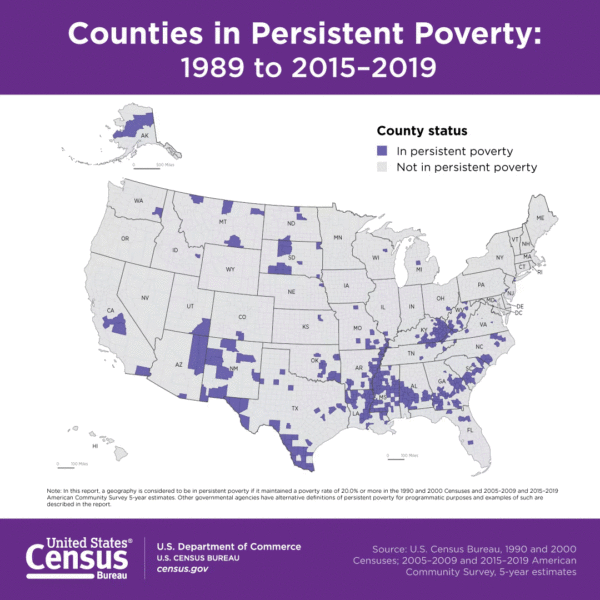Persistent Poverty at County and Census-Tract Level [REPORT]
May 16, 2023

The U.S. Census Bureau released a new report, “Persistent Poverty in Counties and Census Tracts.” While definitions vary, geographies are typically considered to be in persistent poverty if they maintained poverty rates of 20% or more for 30 years.
The report examines county and subcounty geographies (specifically, census tracts), identifying additional populations that may benefit from targeted intervention. It explores census tracts over the same 30-year period (1989 to 2015-2019) as counties allowing for a more direct comparison.

Research suggests that people living in higher poverty areas experience more acute systemic problems (such as limited access to medical services, healthy and affordable food, quality education and civic engagement opportunities) than those in lower poverty areas. Government agencies and researchers have previously identified counties with high rates of poverty over an extended period as targets for increased levels of support.
To identify geographies in persistent poverty, this report incorporates poverty estimates from the 1990 and 2000 Censuses and the 2005–2009 and 2015-2019 American Community Survey (ACS) 5-year estimates. Other governmental agencies have alternative definitions of persistent poverty for programmatic purposes and examples of such are described in this new report.
Persistent poverty is different from and should not be confused with chronic poverty. Chronic poverty identifies individuals and families consistently in poverty over time; persistent poverty in this report focuses on geographic locations that had high poverty rates for an extended time.
Report highlights:
- From 1989 to 2015–2019, 341 out of 3,142 counties, or 10.9% of U.S. counties, were in persistent poverty.
- Approximately 6.1% of the U.S. population lived in a persistent poverty county.
- From 1989 to 2015–2019, 8,238 or 11.3% of census tracts were in persistent poverty. Approximately 9.0% of the U.S. population lived in a persistent poverty census tract.
- In 2015-2019, about 9.1 million more people lived in a persistent poverty tract than lived in a persistent poverty county. Census tracts provide a more geographically precise view than counties in identifying persistent poverty populations.
- Over 74% of persistent poverty census tracts were not in a persistent poverty county.
To download report, CLICK HERE.































